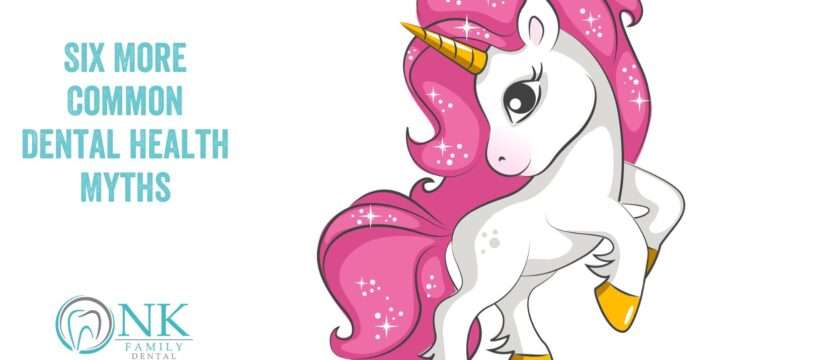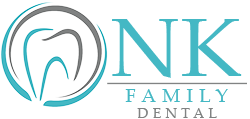
When it comes to dental health, there are a lot of misconceptions and outright bad information that’s spread online or by old-fashioned word-of-mouth. Because professional dental journals aren’t on most people’s reading list, you may have picked up on some of this misinformation and accepted it as fact. Unfortunately, we at NK Family Dental have found that it’s time for a follow-up to our earlier blog posts —“Common Dental Health Myths” — and “More Common Dental Health Myths” — with six additional myths that are equally harmful.
1. Dental X-rays are Dangerous
Concerns about radiation from dental X-rays are common, but the reality is that the amount of radiation exposure from a dental X-ray is minimal. The unit of measurement for radiation is millisieverts. The average intraoral dental X-ray emits just 0.005 millisieverts, while a panoramic X-ray gives off .01 millisieverts. In addition, advancements in dental technology have significantly reduced the amount of radiation exposure from X-rays. Those who are the most concerned about the radiation level of dental X-rays perhaps remember the old-fashioned film X-ray machines. Today’s digital X-rays use much less radiation to create a diagnostic image, and are safe even for pregnant women.
2. Tooth Loss is Genetic
If you have a parent and/or grandparent — as well as other immediate family members who started losing teeth at a relatively early age — you may feel that you’re fated to do likewise. Believing this myth often becomes a self-fulfilling prophecy, since you might give up on following a good oral health regimen because you think it’s no use, anyway!
While there are certain genetic conditions that can predispose you to oral health disorders, the Texas A&M College of Dentistry reports that they are rare. Lifestyle choices and one’s commitment to oral hygiene and regular dental checkups — as well as following up on necessary treatment — play a much more significant role in how long you’ll keep your teeth. The main reasons for tooth loss are periodontal (gum) disease and cavities. The better your oral hygiene and care, the better your likelihood of preventing edentulism — the medical term for partial or complete tooth loss.
Factors contributing to edentulism include the following:
- Tobacco use and vaping.
- Making fast foods, sodas and sweets the mainstay of your diet.
- Certain prescription medications — particularly those that cause dry mouth, which can create a breeding ground for germs and bacteria.
- Certain medical conditions — such as hypertension (high blood pressure), diabetes, heart disease and rheumatoid arthritis — may increase your chances of periodontal disease, which can result in tooth loss if left untreated.
So you may be encouraged to learn that you’re not necessarily destined for dentures or dental implants at a young age! While you love your relatives, if you take an objective look, those who lost their teeth by age 50 might have been at high risk because of the factors listed above, combined with a lack of proper oral hygiene practices and regular dental checkups. Our blog post — “What is Edentulism?” — covers this topic in detail.
3. Gum Disease is Irreversible
Although periodontal disease can have a domino effect in tooth loss, it can be successfully treated if diagnosed early. Gingivitis is the first stage of periodontal disease; chronic periodontitis is the advanced stage. Signs of gingivitis include swollen or inflamed (red) gums, as well as bleeding gums during brushing.
No matter what TV commercials for certain toothpaste brands tell you, see your dentist if your gums bleed during brushing! Bleeding gums always indicate a condition that needs immediate attention. Brushing with one particular toothpaste brand won’t treat the cause. Your dentist may recommend a particular brand after an examination and diagnosis of gingivitis, but attempting to diagnose and treat yourself based on a TV commercial will put your oral health at serious risk. Our blog post —“What You Need to Know About Bleeding Gums” — covers this topic in detail.
Gum scaling and root planing (SRP) is the typical treatment for gingivitis. Also known as a deep cleaning, this is a two-step procedure in which the dentist or dental hygienist goes deep under the gumline with manual hand instruments, ultrasonic instruments, or both, to remove plaque and tartar. This is immediately followed by root planing — an even deeper dive with detailed scaling of the root surface to smooth out rough areas. Root planing decreases gum tissue inflammation, allowing your gums to heal and reattach themselves more firmly to your teeth. Our blog post — “What is Scaling and Root Planing?” — covers this topic in detail.
4. Crowns and Fillings Protect Against Future Decay
Dental crowns and fillings serve specific purposes, but will not prevent your teeth from decay, or future decay. A dental crown can be used as a restoration for a damaged tooth, a tooth that’s undergone root canal treatment, or in cosmetic dentistry as part of a “smile makeover.” Although the tooth is covered to just below the gumline, it has some degree of protection, yet can still be susceptible to decay. In case you were wondering, flossing is still very much necessary between crowned teeth.
An uncrowned tooth with a filling can develop decay in other areas of the tooth. To prevent future cavities, a dental sealant applied by your dentist will provide protection to the grooved chewing surfaces of the molar and premolar teeth, where decay is more likely to occur.
5. It Doesn’t Matter What Time of Day You Brush Your Teeth
Actually, it does. Brushing before bedtime is important because it removes plaque and food particles, preventing bacteria from producing acids that cause tooth decay and gum disease during the long period of sleep. Saliva production decreases overnight, reducing your mouth’s natural ability to wash away harmful substances, so nighttime brushing is crucial to neutralize acids and protect your tooth enamel from damage.
As for morning brushing, you may be surprised by the following advice from Colgate:
“When you should brush your teeth depends on what you eat. Breakfast staples like orange juice and coffee are notoriously acidic. Brushing your teeth right after eating or drinking acidic foods can cause damage to your tooth enamel. The American Dental Association recommends waiting at least 60 minutes after eating or drinking acidic foods or drinks before brushing your teeth. If you don’t have time to wait, it might be best to brush your teeth before eating in the morning and rely on sugar-free gum or sugar-free breath mints to freshen your breath and moisten your mouth.
“For those who don’t drink coffee, tea or orange juice or eat other acidic foods, brushing after breakfast can help remove food particles and plaque buildup while freshening your breath.”
6. Brushing Your Teeth Thoroughly Before Your Dental Checkup Will Hide Negligent Oral Hygiene
No way! As Golden State Dentistry puts it, “No matter how thoroughly you brush and floss your teeth before your dental hygiene visit, your dentist will still be able to tell what your regular habits are, like whether you brush and floss regularly, smoke, or drink soda. For example, if you do not brush your teeth regularly, hard tartar forms on your teeth that you cannot get rid of with brushing alone. If you do not floss, your gums will appear swollen, red, and may even bleed during your dental hygiene visit. Bleeding gums and the amount of tartar are dead giveaways to poor oral hygiene.”
In short, a dental exam isn’t like a college exam. You can’t cram for it!
The Take-Home Message
As we hope you’ve learned, what you’ve been led to believe about dental health isn’t necessarily true. In these cases, what you don’t know can hurt you, so the best person to dispel myths and give you the facts is your dentist!
At NK Family Dental, it is our mission to provide the highest quality and most compassionate oral care to our Chicago patients, including both dental and periodontal services. Our practice is trusted for advanced oral surgery procedures and comfortable root canal treatment.
Our team of experienced, dedicated dental professionals will help address your oral health concerns, and determine the best solution for you based on your individual situation. We strive to identify treatment options that fit your needs.
Our dental specialists include our general dentist, Dr. Nilofer Khan, our endodontist, Dr. Sabek, and our periodontist, Dr. Amir Danesh. Dr. Danesh is a board-certified periodontist and Diplomat of the American Board of Periodontology. He has contributed to the publication of two books, as well as published over 20 papers in prestigious dental research journals.
We serve the neighborhoods of Logan Square, Bucktown, Humboldt Park, and Wicker Park with the dedication that’s earned us the reputation as the Best Dentist in Chicago!
We understand that the main concern you may have is cost, which is why we accept all major PPO plans for dental insurance and also offer our in-house dental plan. Please see our financing page for more information.
Schedule your visit through ZocDoc, or contact us directly. We look forward to treating you soon!
